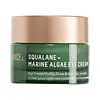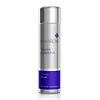What's inside
What's inside
 Key Ingredients
Key Ingredients

 Benefits
Benefits

 Concerns
Concerns

 Ingredients Side-by-side
Ingredients Side-by-side

Water
Skin ConditioningCaprylic/Capric Triglyceride
MaskingSqualane
EmollientGlycerin
HumectantSorbitan Olivate
EmulsifyingCetearyl Olivate
Jojoba Esters
EmollientGlyceryl Stearate Se
EmulsifyingPanthenol
Skin ConditioningHydroxyethyl Acrylate/Sodium Acryloyldimethyl Taurate Copolymer
Emulsion StabilisingCetyl Palmitate
EmollientSpilanthes Acmella Flower Extract
Skin ConditioningPalmitoyl Tripeptide-5
Skin ConditioningSorbitan Palmitate
EmulsifyingDunaliella Salina Extract
Skin ConditioningAstaxanthin
Skin ConditioningSodium Hyaluronate
HumectantPhenoxyethanol
PreservativeEthylhexylglycerin
Skin ConditioningTocopherol
AntioxidantCitric Acid
BufferingWater, Caprylic/Capric Triglyceride, Squalane, Glycerin, Sorbitan Olivate, Cetearyl Olivate, Jojoba Esters, Glyceryl Stearate Se, Panthenol, Hydroxyethyl Acrylate/Sodium Acryloyldimethyl Taurate Copolymer, Cetyl Palmitate, Spilanthes Acmella Flower Extract, Palmitoyl Tripeptide-5, Sorbitan Palmitate, Dunaliella Salina Extract, Astaxanthin, Sodium Hyaluronate, Phenoxyethanol, Ethylhexylglycerin, Tocopherol, Citric Acid
Water
Skin ConditioningGlycerin
HumectantPEG-40 Hydrogenated Castor Oil
EmulsifyingPentaerythrityl Tetraisostearate
EmollientPanthenol
Skin ConditioningC12-15 Alkyl Benzoate
AntimicrobialButylene Glycol
HumectantPalmitoyl Oligopeptide
CleansingPalmitoyl Tetrapeptide-7
Skin ConditioningAcetyl Hexapeptide-8
HumectantTribehenin
EmollientCeramide Ng
Skin ConditioningPEG-10 Phytosterol
EmulsifyingPalmitoyl Hexapeptide-12
Skin ConditioningTocopheryl Acetate
AntioxidantAcrylates/C10-30 Alkyl Acrylate Crosspolymer
Emulsion StabilisingAscorbyl Tetraisopalmitate
AntioxidantDisodium EDTA
Helianthus Annuus Seed Oil
EmollientRosmarinus Officinalis Leaf Extract
AntimicrobialGlycine Soja Oil
EmollientRetinyl Palmitate
Skin ConditioningTocopherol
AntioxidantCarbomer
Emulsion StabilisingPolysorbate 20
EmulsifyingCaprylyl Glycol
EmollientPhenoxyethanol
PreservativeEthylhexylglycerin
Skin ConditioningPolyglyceryl-10 Laurate
Skin ConditioningMethylparaben
PreservativeSodium Hydroxide
BufferingPropylparaben
PreservativeLactic Acid
BufferingWater, Glycerin, PEG-40 Hydrogenated Castor Oil, Pentaerythrityl Tetraisostearate, Panthenol, C12-15 Alkyl Benzoate, Butylene Glycol, Palmitoyl Oligopeptide, Palmitoyl Tetrapeptide-7, Acetyl Hexapeptide-8, Tribehenin, Ceramide Ng, PEG-10 Phytosterol, Palmitoyl Hexapeptide-12, Tocopheryl Acetate, Acrylates/C10-30 Alkyl Acrylate Crosspolymer, Ascorbyl Tetraisopalmitate, Disodium EDTA, Helianthus Annuus Seed Oil, Rosmarinus Officinalis Leaf Extract, Glycine Soja Oil, Retinyl Palmitate, Tocopherol, Carbomer, Polysorbate 20, Caprylyl Glycol, Phenoxyethanol, Ethylhexylglycerin, Polyglyceryl-10 Laurate, Methylparaben, Sodium Hydroxide, Propylparaben, Lactic Acid
 Reviews
Reviews

Ingredients Explained
These ingredients are found in both products.
Ingredients higher up in an ingredient list are typically present in a larger amount.
Ethylhexylglycerin (we can't pronounce this either) is commonly used as a preservative and skin softener. It is derived from glyceryl.
You might see Ethylhexylglycerin often paired with other preservatives such as phenoxyethanol. Ethylhexylglycerin has been found to increase the effectiveness of these other preservatives.
Glycerin is already naturally found in your skin. It helps moisturize and protect your skin.
A study from 2016 found glycerin to be more effective as a humectant than AHAs and hyaluronic acid.
As a humectant, it helps the skin stay hydrated by pulling moisture to your skin. The low molecular weight of glycerin allows it to pull moisture into the deeper layers of your skin.
Hydrated skin improves your skin barrier; Your skin barrier helps protect against irritants and bacteria.
Glycerin has also been found to have antimicrobial and antiviral properties. Due to these properties, glycerin is often used in wound and burn treatments.
In cosmetics, glycerin is usually derived from plants such as soybean or palm. However, it can also be sourced from animals, such as tallow or animal fat.
This ingredient is organic, colorless, odorless, and non-toxic.
Glycerin is the name for this ingredient in American English. British English uses Glycerol/Glycerine.
Learn more about GlycerinPanthenol is a common ingredient that helps hydrate and soothe the skin. It is found naturally in our skin and hair.
There are two forms of panthenol: D and L.
D-panthenol is also known as dexpanthenol. Most cosmetics use dexpanthenol or a mixture of D and L-panthenol.
Panthenol is famous due to its ability to go deeper into the skin's layers. Using this ingredient has numerous pros (and no cons):
Like hyaluronic acid, panthenol is a humectant. Humectants are able to bind and hold large amounts of water to keep skin hydrated.
This ingredient works well for wound healing. It works by increasing tissue in the wound and helps close open wounds.
Once oxidized, panthenol converts to pantothenic acid. Panthothenic acid is found in all living cells.
This ingredient is also referred to as pro-vitamin B5.
Learn more about PanthenolPhenoxyethanol is a preservative that has germicide, antimicrobial, and aromatic properties. Studies show that phenoxyethanol can prevent microbial growth. By itself, it has a scent that is similar to that of a rose.
It's often used in formulations along with Caprylyl Glycol to preserve the shelf life of products.
Tocopherol (also known as Vitamin E) is a common antioxidant used to help protect the skin from free-radicals and strengthen the skin barrier. It's also fat soluble - this means our skin is great at absorbing it.
Vitamin E also helps keep your natural skin lipids healthy. Your lipid skin barrier naturally consists of lipids, ceramides, and fatty acids. Vitamin E offers extra protection for your skin’s lipid barrier, keeping your skin healthy and nourished.
Another benefit is a bit of UV protection. Vitamin E helps reduce the damage caused by UVB rays. (It should not replace your sunscreen). Combining it with Vitamin C can decrease sunburned cells and hyperpigmentation after UV exposure.
You might have noticed Vitamin E + C often paired together. This is because it is great at stabilizing Vitamin C. Using the two together helps increase the effectiveness of both ingredients.
There are often claims that Vitamin E can reduce/prevent scarring, but these claims haven't been confirmed by scientific research.
Learn more about TocopherolWater. It's the most common cosmetic ingredient of all. You'll usually see it at the top of ingredient lists, meaning that it makes up the largest part of the product.
So why is it so popular? Water most often acts as a solvent - this means that it helps dissolve other ingredients into the formulation.
You'll also recognize water as that liquid we all need to stay alive. If you see this, drink a glass of water. Stay hydrated!
Learn more about Water